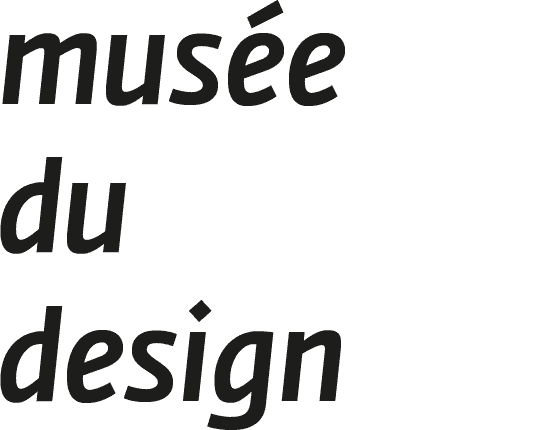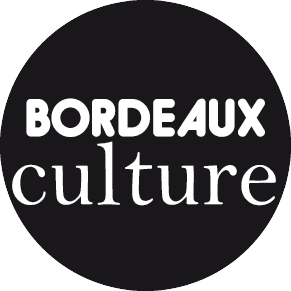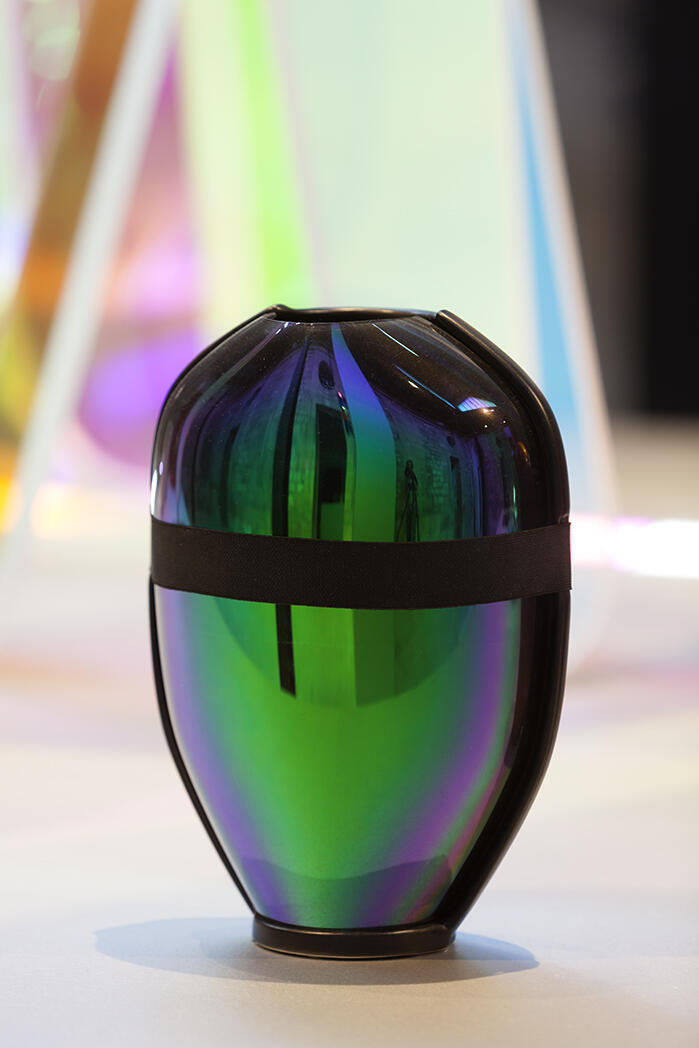Flower vases
Around some vases from the madd-bordeaux collection
Vases "with flowers": a strange precision, are not all vases intended to receive flowers? A look at the history of decoration and furnishing shows that this precision is important. The art historian Henry Havard, in his famous Dictionary of Furnishing and Decoration, indicates that the word "vase" is a "general term applied to all kinds of vessels and is used to designate containers of all shapes and nature, intended to contain liquors, fruits, flowers, perfumes, or simply to be used for decoration." (1) There follows a plethora of specific names, designating as many forms specific to certain periods, used in different regions of the world, as different uses, which the historian groups all in the large family of vases: "Ewers, bedaines, bernigants, brocades, brocarts, buires, bukets, burettes, canes, chopines, canters, coquasses, cups, creusequins, cimaises, estamoies, godets, grasels, hanaps, the justes, the lots, the pichiers, the pints, the pochonnes, the various kinds of pots, the potkins, the quartes, the refrédouers, the cups, the setiers, the thiphenies, the tonnelets, the tripets, the tupins, the urns, the basins, the glasses, the ydres [... ]. " For several centuries, the inventories after death of the great collectors of the Old Regime and the auctions of art lovers are full of these lists in the Prevert of forms of vases.
These objects are not only containers, they also contribute to enhance their contents. The height, width and neck opening of a vase determine the appearance of the bouquet and its distribution in space. The 1955 edition of the Nouveau Larousse ménager reminds us that the high shape is intended to receive long stems and is suitable for "large bouquets" and that vases of this type "must be flared and not constricted", while the wide shape is suitable for flowers with short stems. The color of the vase, its material qualities of brilliance, transparency or mattness, but also its location are all criteria to be observed so that the vase can fully fulfill its decorative and display functions in the domestic space.
The vase is this banal object -in its absence, a glass or a pitcher can easily fulfill its primary function- which has been given, over time, political, commercial or religious values. The passion for porcelain of the Elector of Saxony and King of Poland, Augustus the Strong (1670-1733), is a good example: in 1717, the sovereign exchanged a regiment of 600 soldiers with the King of Prussia for 152 porcelain vases from the Kang-Xi period. The number of Sèvres vases offered as diplomatic gifts since the creation of the royal factory, initially in Vincennes in 1745, is uncountable.

Collection « Blister », 2004
Edition Design Gallery Milano
Metal, glass
H. 22 ; L. 72 ; Pr. 19,7 cm
Inv. madd 2014.9.1
Andrea Branzi sums up in a few words the ambiguity of this object that is as futile as it is necessary: "There are civilizations that have not had architecture, but all of them have had vases, this indispensable useless object." (2) Around this universal object, the Italian designer imagines different stories, paying particular attention as much to the object as to the way it will allow the placement of the different stems, branches and flowers. Acquired by the Museum of Decorative Arts and Design (madd-bordeaux) in 2014, the Golden Gate vase (2004) is composed of four glass containers resting on a lacquered metal plate, above which rises a portico, like a gilded metal arbor, whose grid allows for a certain distance between each flower in the composition. More than a vase, the Italian designer imagines here a small architecture to support the flowers, allowing to create as many ephemeral paintings.
Like all domestic objects, vases are marked by successive stylistic periods, sometimes marked by opulence and decorative richness, sometimes by sobriety. And it wasn't until the first half of the 20th century that voices were raised against the indiscriminate use of colors or decorations that would disturb the appreciation of the vases' form. Thus the architect Jean-François Sobry, in the work De l'architecture published in 1776, expresses his point of view: "The vases must draw all their decoration from their form and their chiseling. It is a mistake to paint them with several colors. The paints with which some load them corrupt the form and make stain. One can make them of the brightest color, but it must be one. (3)
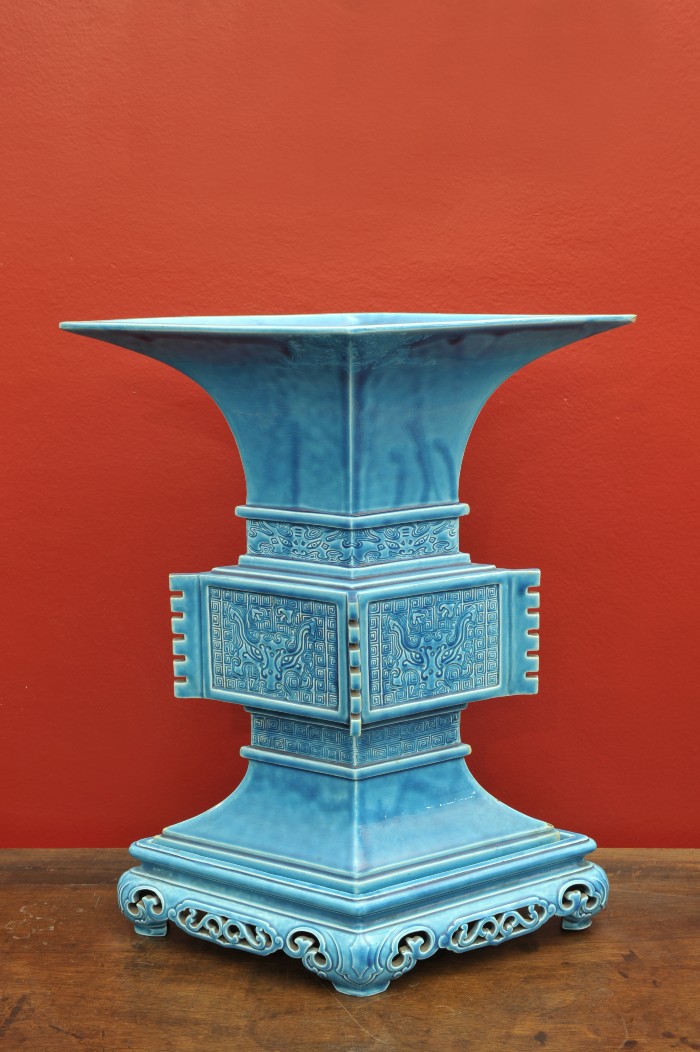
Bordeaux Faïence, Vers 1880-1890
Glass Earthenware
H. 43 ; L. 37,2 cm
Inv. madd 73.1.427
Some forms of vases have survived through the ages, such as Chinese ritual vases, made of bronze several centuries before our era. We find them in Europe, made of porcelain, stoneware, earthenware, glass or silver metal, in modern and contemporary periods. They lose their religious and sacred character, but become canonical. They integrate the vocabulary of the forms of the great earthenware factories which flourish, particularly in Europe, throughout the 19th century. Among them, the J. Vieillard & Cie factory, active in Bordeaux between 1845 and 1895, produced numerous vases, whose forms came from the great collections of Asian art that were then being built up in the West, with the reopening of Japan to international trade.
The roll form is also found in different periods and in several regions of the world. It is around this simple form, the cylinder, that the designer Pierre Charpin conceived his five series of vases with the CIRVA between 1998 and 2001, preferring to keep his distance from the infinite possibilities of forms offered by the work of glass: "The cylinder as a container (vase), as a form of revolution (elementary) characteristic of the technique of blowing." (4) By declining this volume in different colors, in association with flat shapes, Pierre Charpin produces what he calls a landscape, constituted by a set of pieces that dialogue with each other. The vase acquired by the madd-bordeaux in 2016 belongs to the series "Lisse" (1999-2000) and is composed of a high orange tube on which is placed a thick green glass plate. In the center of it, a hole reminds us that this beautiful simple volume, which is entirely color, is indeed a vase.
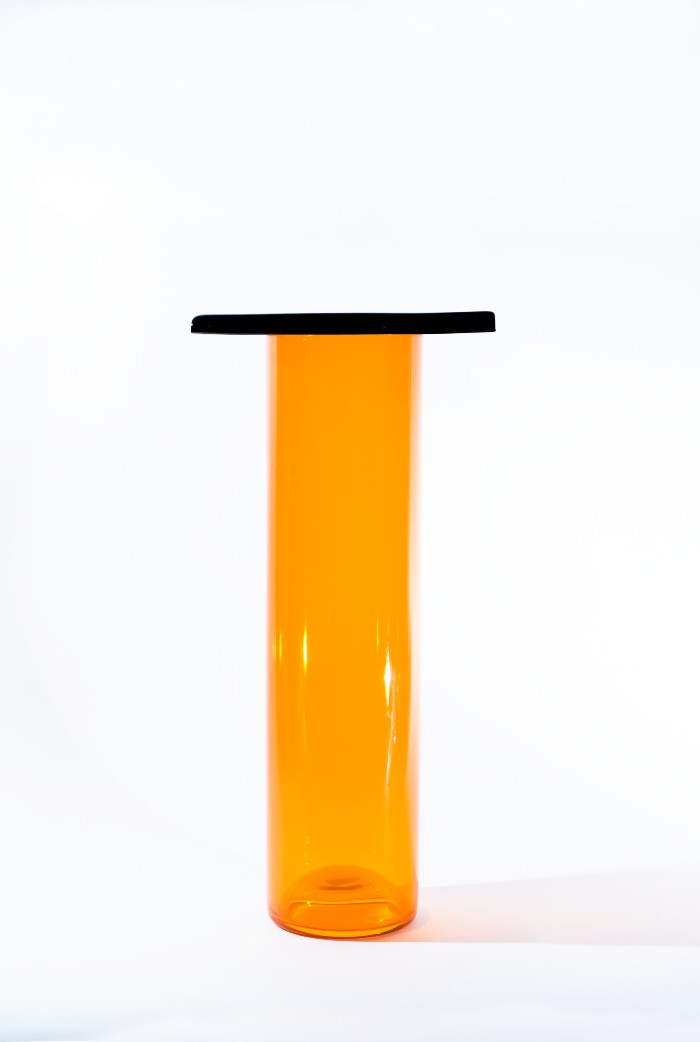
Édition Galerie Kreo en collaboration avec le Cirva, 2005
Blown glass
H. 59 ; L. 28 cm
Inv. madd 2016.12.1
Shapes endure and become perennially embedded in our visual culture. It is precisely by playing on our almost instinctive recognition of forms that Israeli artist Efrat Eyal has conceived two series entitled "A Greek Tragedy" (2012-2013), of which the Kneeling Women vase acquired by madd-bordeaux in 2018 is part. This vase, which by its shape and colors seems to come from Greco-Roman antiquity, was designed from casts of everyday objects of the artist. On an ancestral form, Efrat Eyal invents a new narrative: the gladiators and Greek gods are replaced by photographs representing a naked woman busy with domestic tasks (cleaning, ironing...) from a series of the photographer Eadweard Muybridge. The friezes of motifs that decorate the upper part of the body as well as the neck are composed of stylized representations of objects associated with the domestic space: brushes, feather dusters, hair clips, carpet rackets, can easily be confused with the friezes of palmettes or geometric motifs that we find on the ancient vases with red figures. By diverting the photographs of the famous English photographer, by playing on our perception of objects that are part of our visual culture, this vase, domestic object par excellence, denounces the place of women in society, assigned to the domestic space.
In recent decades, many designers have taken up the vase as an object to challenge our understanding of form and our social understanding of the object. The madd-bordeaux, which keeps nearly 500 vases, has recently acquired several pieces that invite us to question the typology, its perception and its use.
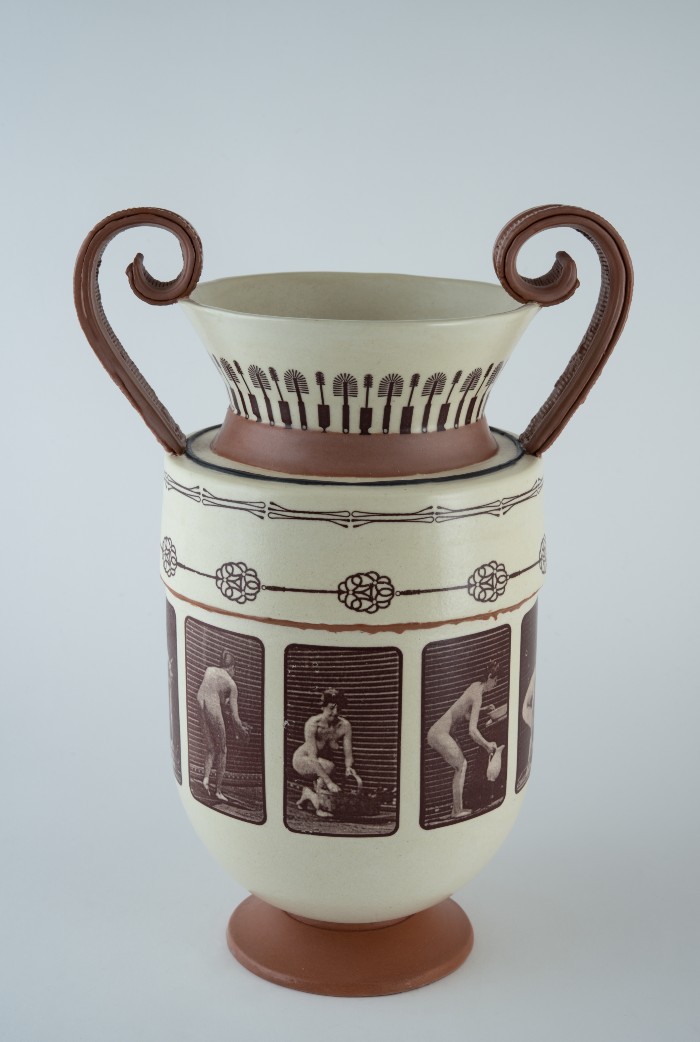
second series « A Greek Tragedy », 2013
Ceramic
H. 29 ; L. 20 cm
Inv. madd 2018.14.2
The Walter vase by designer Daniel Weil is somewhere between a design object, an installation and a sculpture. It is the result of the assembly of a balloon-shaped wine glass, placed in the center of a wood and lacquered metal structure that holds both the glass and the flower. Walter is part of a series of objects called "Still Life", published by Anthologie Quartett from 1984. About this series, the designer underlines: "[...] each one of the pieces in the Still Life series has its own little world because they had to be objects in their own right. They were not designed as a collection or as a set whose styles are rigidly connected. They were intended to be metaphorically connected, and tenuously visually connected." (5) The constructive principle of this vase is abused. Like the cubist artists of the beginning of the 20th century who fascinated him, the designer superimposes the different elements in a precarious and random way. But the deconstruction here is more philosophical than aesthetic or formal. The apparent instability of the vase confers movement and dynamism, and reactivates the debate on the qualities of objects, by questioning with humor its function and use. Like the Claire cup from the same collection, the name Walter was not chosen at random. It comes from a play on words, which also invites reflection on the links between consumers, users, and objects: "[Claire and Walter] were my average consumers, characters created for my degree show. Designers used to believe that the consumers they were designing for did not have any taste, that as manipulators, designers were in the business of dictating what consumers should like. [...] Just as water and air do not have any taste, so Walter and Claire, my average consumers, were tasteless." (6)

Edition Anthologie Quartett
Wood, metal, glass
H. 30 cm ; L. 28 ; Pr. 13,5 cm
Inv. madd 2018.9.3
A fan of experiments associating forms and materials, one year after the Knotted Chair entirely made of a knotted rope and solidified by resin, Marcel Wanders presents in 1997 his bulbous porcelain vases, the Egg Vase. Recycling and shifting are part of his creative process: the Dutch designer obtains the shape by filling condoms with hard-boiled eggs and making casts of the shapes created. The use of a traditional material (porcelain cookie) reinforces the provocative character of the work.
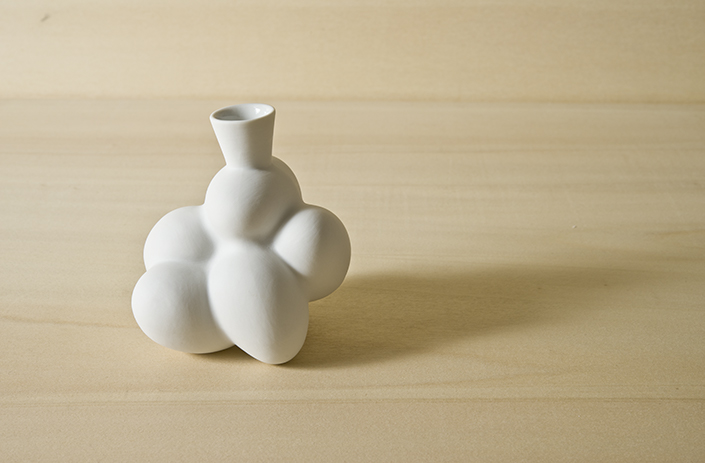
Edition Moooi
Porcelain
H. 10 ; L. 9 cm
Inv. madd 2016.7.2
The universes mix, the inspirations cross and overlap to produce objects of hybrid appearance, which we struggle to identify at first glance. Giant insect or motorcycle helmet? The Scarabée vase imagined by Jean-Baptiste Fastrez is composed of two elements held together by an elastic link: a black ceramic vase and an iridescent PMMA shell. The whole evokes the structure of an insect and the iridescent carapace of a beetle. The large black elastic band and the shell can recall the world of sports. As the designer explains, "I like to pull an object out of its universe and drop it into another to create a new story, like genetic manipulations, I play with the DNA of objects.
How to make a vase disappear? It is with this question that Chris Kabel's Hidden Vase project begins. The solution found was inspired by the troughs of poultry farms. The flowers are arranged around the water container, placed upside down, giving the impression that they grow directly from the support. Of these vases, Chris Kabel explains, "I wanted it to be invisible, but it has become a self-contained object that is self-regulating." The metal structure holds the stems and defines their arrangement in a circle. Then the vase disappears and the flowers shine.
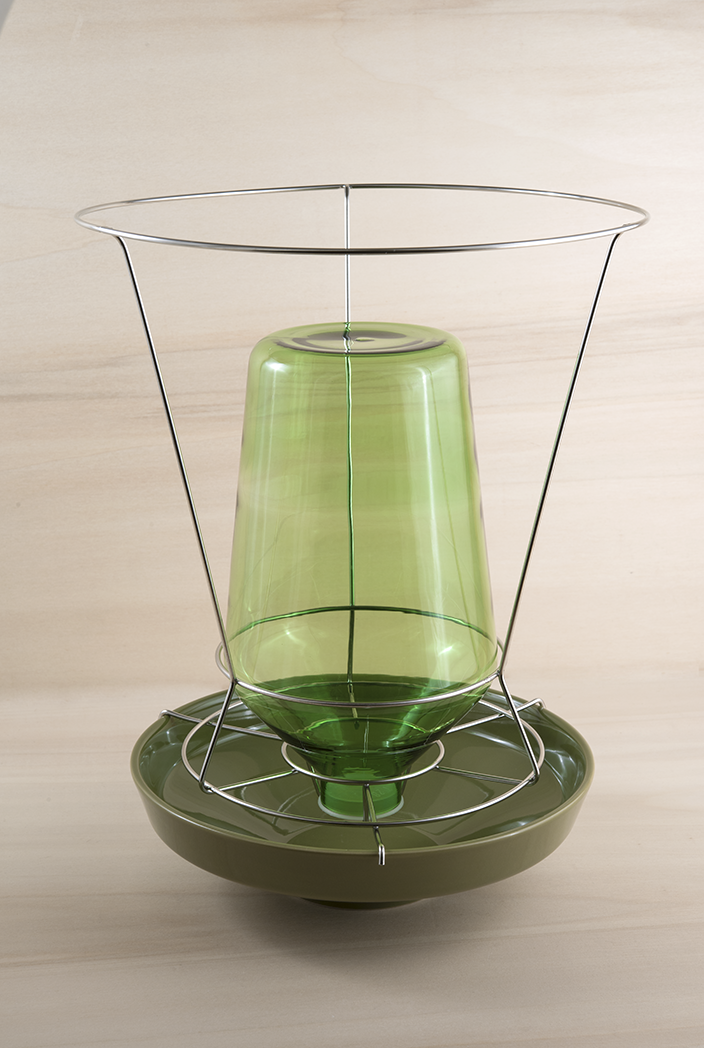
Edition Valerie Objects
Stainless steel, glass, stoneware
H. 37 ; Diam. 29 cm
Inv. madd 2017.14.8
(1) Henry Havard, Dictionnaire de l’ameublement et de la décoration, tome 4, Paris, 1894, p. 1611
(2) Anne-Marie Fèvre, « Andrea Branzi en vases éclos », Libération, 4 juin 2004
(3) Jean-François Sobry, De l’architecture, Amsterdam, 1776, p. 186
(4) Pierre Charpin au Cirva, Grégoire Gardette édition, Nice, 2001
(5) C. Thomas Mitchell, New Thinking in Design. Conversations on Theory and Practice, New York, 1996, p. 21
(6) Ibid., p. 20
Article written by Etienne Tornier, head of the 19th-XXIst century collections at madd-bordeaux
Extract from the catalog of the exhibition Offrir des fleurs presented at the Pavillon de l'Arsenal from April 2021, as part of the Agora curatorial grant obtained in 2019 by Christopher Dessus, curator of the exhibition. Supported by Agora du design, the work is published by Pli éditions and Paf atelier and distributed by les presses du réel.
The exhibition Offering Flowers is an allegorical form of the "agora", a space for exchange and sharing, to create a common territory composed of the richness of collective work and imaginations of tomorrow. It marks the introduction of an ambitious research on the consideration of flowers as a contemporary design object, enabled by the Curator's Agora grant obtained by Christopher Dessus in 2019. It embraces the social, economic, ecological, aesthetic and sensitive issues that flowers raise. More info: https://offrirdesfleurs.eu/

